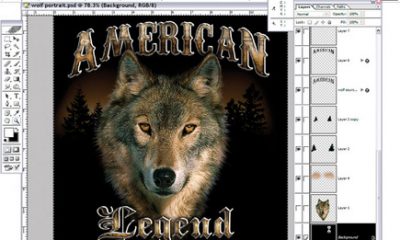Digital Printing
Published
16 years agoon
We have all heard the mantra: Our clients are becoming our competitors. For example, many screen printers have clients from the other side of the printing world, who specialize in offset, flexo, and other graphics-printing processes. They contract work to the screen shops. Manufacturers of large-format inkjet printers are now focusing on these other prospects as very real markets for their products. In a nutshell, they are selling to our clients. And these are clients whose companies are usually many times larger than their suppliers of digital imaging.
The equipment purchased by the others in the printing industry—including photo, reprographics, small-format digital, and diecutters/finishers—tends to be priced into the millions of dollars; therefore, the $400,000 flatbed inkjet printer seems to be a tolerable investment—and one that offers promises of vast returns. That’s one of the biggest lures for other kinds of printing specialists to buy into wide-format digital.
Trade-show talk
My experiences at SGIA ’07 further solidified the notion that clients are becoming competitors. Each of the eight manufacturers of large-format inkjet printers I quizzed at the trade show reiterated the existence of untapped markets in offset, flexo, and so on. Seven out of the eight believe the others will be a larger market for them in the near future. Three main factors assist in the prediction: resources from these larger printers/finishers, vast experience in the printing and color industries, and the most important factor, which is a client list that reflects a who’s who of consumer products. The inkjet salesperson comes to these facilities armed with the ultimate pitch, “Look what you can sell to your existing client base.”
The 2007 GraphExpo trade show in Chicago was another prime example of the cross selling into the large-format market. GraphExpo has, for the past few years, presented a very extensive print pavilion dedicated to digital imaging. Though printers/dealers typically attend GraphExpo to see advances in offset, flexo, and small-format digital, printers and vendors from the conventional graphics industry were wowed and introduced into our arena of wide-format digital.
Leverage
In the cities that have a very strong offset market are many potential prospects for large-format inkjet equipment. In my Milwaukee backyard alone, we have 20 full-color offset printers, each with nice, loyal accounts. Which has the Coke account? Which has the Pepsi account? Good salespeople know this answer. And who else may be servicing these high-end clients with wide-format digital prints? It could quite likely be a local screen shop. Competition is very keen in the offset world, just as it is in ours. They are looking for ways to leverage their valuable client lists into more sales and new market niches. Our digital-imaging world has a very huge target on it.
How products are sold in the graphics world assists in the cross selling of digital imaging equipment to the others, as companies like HP, Fujifilm/Sericol, Kodak, Agfa, and Pitman/ Charrette serve most print markets. The same company that sells offset plates also sells large-format digital devices. The technology is tailor made to cross sell into our world and to grey our market.
If the large corporations bring awareness of our unique part of the world to other print sectors, it is the local graphicart- supply companies (distributors/dealers) that will be their voice. Margins for consumables for these distributors have become more and more narrow with fewer products to offer. These vendors must also remake their image in this direct-to world and continually find new products to sell to their existing client base. The local distributors are taking on lines of narrow and wide-format digital equipment, and the excitement they feel is added consumables sales in the form of inks and substrates—products that they know how to sell, procure, and market.
The print-equipment manufacturers are arming the local distributors with sales and marketing strategies to advance the market for large-format digital. To expand my point, #1 Network, a company that is a volume-purchasing arm for dealers around the country, brought its dealer clients to the SGIA show to educate them about opportunities in large-format digital. I do think our market is getting the attention of many people.
Low cost of entry
The notion that our clients become our competitors is a product of digital imaging’s comparatively low cost of entry, particularly in the prepress sector. Prepress workstations that once were made by Hell and Scitex had a price tag of more than a million dollars, but then the Mac/PC platforms invaded the workspace. Consequently, workstations became affordable to the design firms, ad agencies, and corporate marketing departments, all but eliminating the classic prepress firm. I am not predicting the fall of the classic digital printer, though the door is opening to our other friends who are looking for additional revenue sources.
Which of the other sectors will be next to add large-format digital printing? I would say the companies that were early adopters of the smaller format digital printers (Kodak Nexpress, Xerox iGen, and HP Indigo). Firms that utilize these color printers tend to serve the consumer-product accounts that want color and also buy point-of-sale graphics. Direct-mail printers have evolved into direct-marketing firms, in which point of sale is the ultimate direct sale. One-to-one marketing is their formula, which dovetails into large-format digital print. The cross sell is perfect, and the internal staff is ramped up on critical color expertise and digital-file repurposing for digital printing. The challenge the small-format sector faces is material handling and finishing.
The classic 40-in. offset printers have taken hits to their livelihoods at multiple fronts by digital printing, customization requirements, Internet-based or electronic marketing, and other offset printers (small-format offset to miniweb offset) squeezing their ideal print volume. Therefore, they are looking at our digital market to recapture sales. Just in Milwaukee, we have eight printers and one finishing/diecutting company that have adopted wide-format digital printing to address their woes. Management from one trade house that produces direct-to-plate for the offset trade (which is very depressed, as most offset printers have their own DTP systems) actually asked my advice on a flatbed printer that they saw at GraphExpo.
The color crowd
The cross selling of digital printing devices is happening on the color-measurement and verification scene, too. XRite found its place in the screen-printing market in the color matching of the screen shops’ inkrooms and now sees a market to color manage and profile in digital imaging. EFI bought VUTEk and now has its cross hairs on the market for inkjet RIPs, in which names like Wasatch and Onyx have dominated.
Companies like EFI and X-Rite have a long history within the offset/flexo industries that has fostered the advance of color management and prediction. They bring this experience and methodology to the industry for large-format digital printing. This, in turn, filters to the screen-print workplace, where large-format inkjet has gained ground as a complementary technology. The color-management companies’ focus on repeatable color proofing is redefining how we look at our processes. The prepress workflow for offset and flexo is predicated on the least amount of touches, contract proofs for sign offs, instantaneous alterations and approvals, on-press monitor proof, and the use of monitors (soft proofing) for all of the above.
Remote proofing is the newest push into the large-format industry from our friends in offset/flexo— proofing via our computer screens. The vendors involved in color management are working through our advertising clients to specify this method of prepress proofing. It was the buzz to streamline yet another process that we touch and feel, with the goal of reducing costs and time frames. For example, one major beer company is attempting to implement remote proofing in the P-O-P print environment, and the screen/digital print providers that service the brewer came armed to investigate the options at the SGIA Expo.
They will come
If there is a void in service, the others will come. And the invading others bring their culture with them as they descend on our turf. What will happen as a result of this invasion? We will see more local competition from non-traditional sources. This also results in increased exposure for the large-format color market—more feet on the street to push the awareness of what may be possible with digital printing. We will also see the technology bar rising in the RIP and production-software fields, as the multitude of providers begin viewing large-format digital as having a viable critical mass. Higher standards and the use of sophisticated color management will come right behind. So, let us not resist or complain, but accept what comes with the evolution of an industry.
Rick Mandel is the owner and president of the Mandel Company in Milwaukee, WI. He also serves as CEO of the company’s Screentech Division, a 115-year-old graphics firm that specializes in large-format color separations for commercial printing companies, as well as digital production of large-format graphics. Mandel is a member of the SGIA and the Association of Screen Printing Sciences. He holds a bachelor-of-science degree from the University of Wisconsin.

Subscribe

Magazine
Get the most important news
and business ideas from Screenprinting Magazine.
Most Popular
-

 Case Studies2 months ago
Case Studies2 months agoHigh-Density Inks Help Specialty Printing Take Center Stage
-

 Art, Ad, or Alchemy2 months ago
Art, Ad, or Alchemy2 months agoF&I Printing Is Everywhere!
-

 Andy MacDougall2 months ago
Andy MacDougall2 months agoFunctional and Industrial Printing is EVERYWHERE!
-

 Columns3 weeks ago
Columns3 weeks ago8 Marketing Mistakes Not to Make When Promoting Your Screen Printing Services Online
-

 Editor's Note2 weeks ago
Editor's Note2 weeks agoLivin’ the High Life
-

 Marshall Atkinson2 weeks ago
Marshall Atkinson2 weeks agoHow to Create a Winning Culture in Your Screen-Printing Business
-

 Thomas Trimingham2 months ago
Thomas Trimingham2 months ago“Magic” Marketing for Screen Printing Shops
-

 News & Trends2 months ago
News & Trends2 months agoWhat Are ZALPHAS and How Can You Serve Them in Your Print Business?






